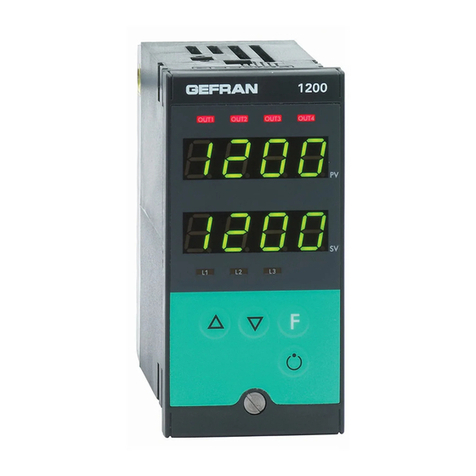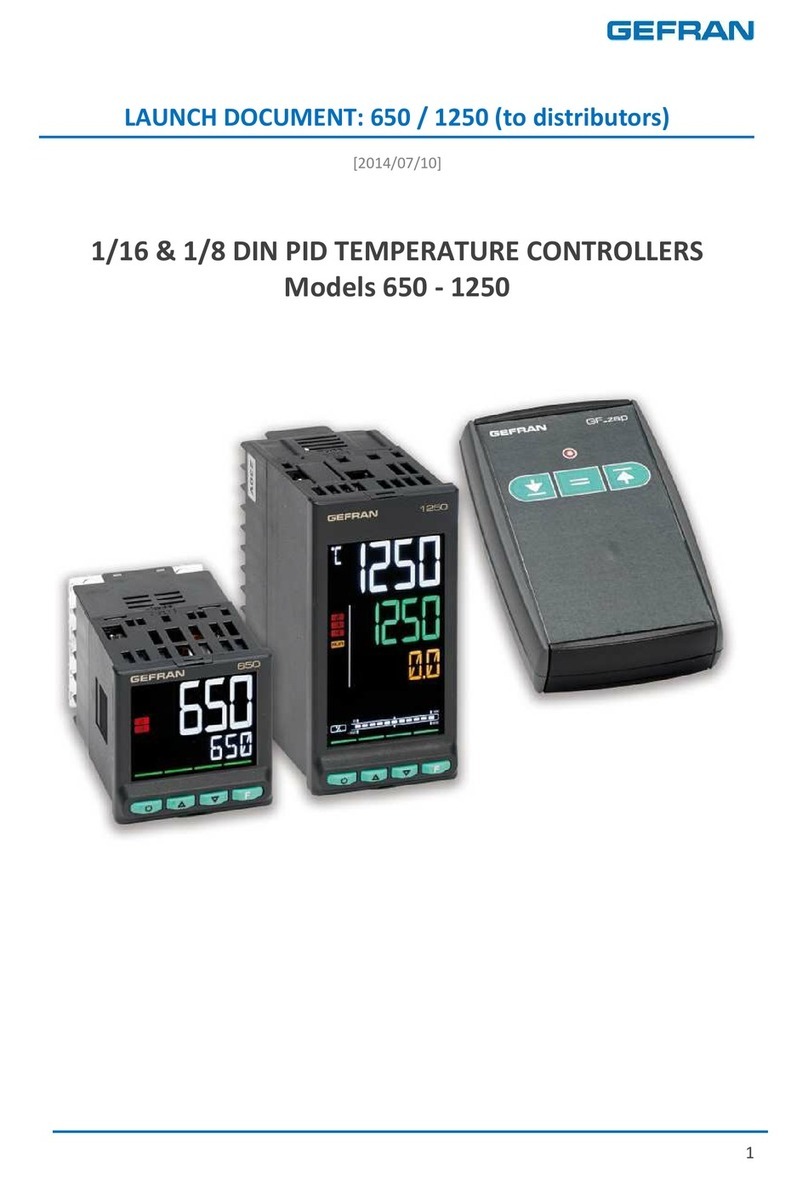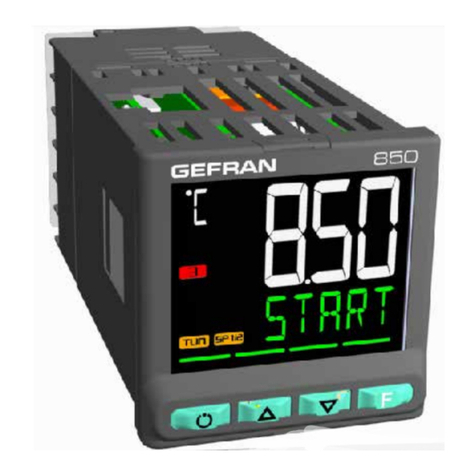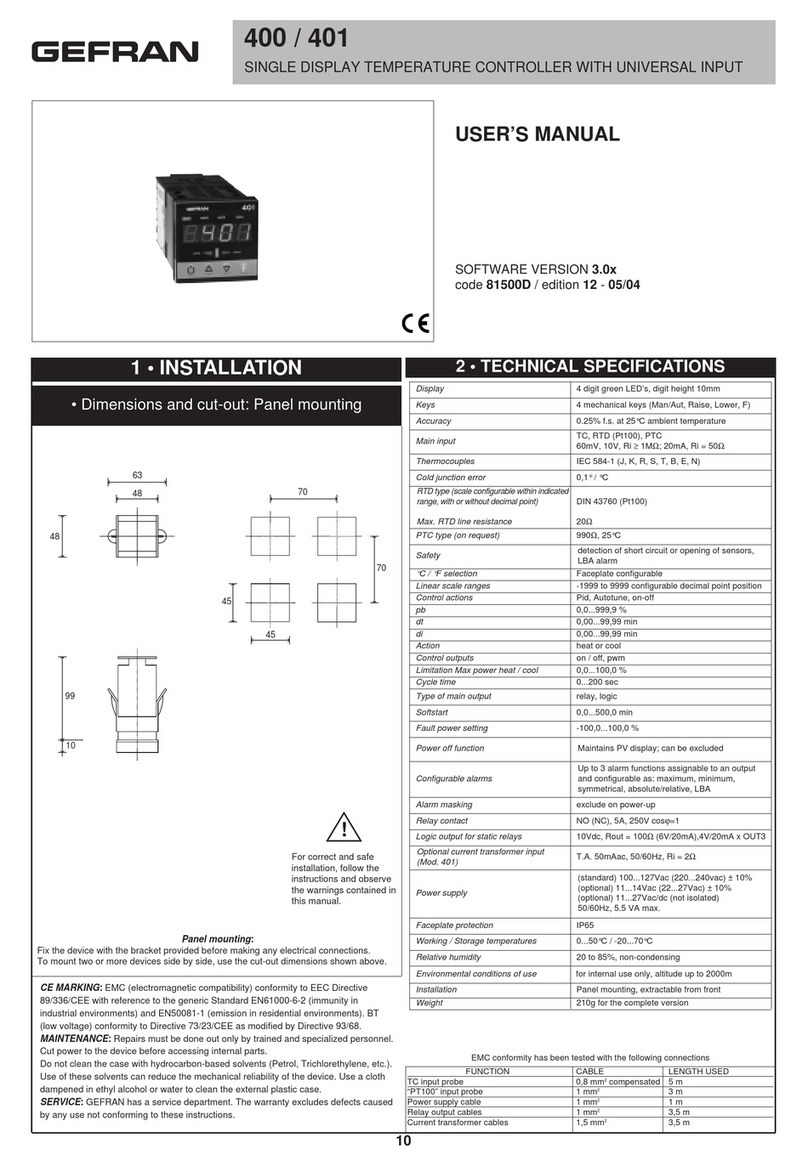8
10 •NOTE DI FUNZIONAMENTO
•FUNZIONE ACCENSIONE-SPEGNIMENTO SOFTWARE
Come spegnere: tramite la combinazione di tasti "F" e "Decrementa" premuti insieme per
5 secondi épossibile disattivare lo strumento, che si predispone in stato di "OFF" assu-
mendo un comportamento simile allo strumento spento, senza togliere l'alimentazione di
rete. Durante lo stato di "OFF" il display éspento, con il puntino decimale lampeggiante
sul secondo digit del display inferiore che indica la presenza della tensione di rete; tutte le
uscite (regolazione e allarmi) sono in stato di OFF (livello logico 0, relédiseccitati) e tutte
le funzioni dello strumento sono inibite eccetto la funzione di "Accensione".
Come accendere: premendo il tasto "F" per 5 secondi lo strumento passa dallo stato di
"OFF" in quello di "ON", effettuando un ciclo di setup identico ad un power-on, con il
lampeggio di tutti i segmenti del display per circa 5 secondi, seguito dal funzionamento
normale secondo la configurazione HW e SW. Se lo strumento éconfigurato con il self-
tuning o il soft start abilitato, verràeseguita la rispettiva procedura come in seguito ad
un power-on. Se durante lo stato di "OFF" viene tolta la tensione di rete, alla prossima
accensione (power-on) lo strumento si predispone nello stesso stato di “OFF"; (lo stato
di "ON/OFF" viene memorizzato). La funzione énormalmente abilitata. Impostando in
fase CFG2 il parametro Pro = Pro + 8 la funzione viene disabilitata.
•FUNZIONAMENTO DEGLI ALLARMI
Gli allarmi possono essere assoluti o relativi, diretti o inversi, relativi simmetrici.
Allarme assoluto: soglia impostata con un valore assoluto rispetto allo 0
(Es. per 1000: set-point = 400, AL1 = 450, AL2 = 350, AL3 = 500).
Allarme relativo: soglia impostata con uno spiazzamento rispetto al setpoint
(Es. per 1000: set-point = 400, AL1 = +50, AL2 = -50, AL3 = +100).
Allarme diretto: relécorrispondente eccitato con variabile controllata oltre il valore di
soglia impostato, sia in modo assoluto che relativo (allarme di massima).
Per allarme HB reléeccitato se la corrente éminore del valore impostato.
Allarme inverso: relécorrispondente eccitato con variabile controllata sotto il valore di
soglia impostato, sia in modo assoluto che relativo (allarme di minima).
Per allarme HB reléeccitato se la corrente émaggiore del valore impostato.
Con allarme relativo simmetrico : lo spiazzamento impostato rispetto al set-point ésia
sommato che sottratto determinando una finestra di intervento.
Con allarmi assoluti le soglie assumono al massimo i valori limite impostati nella fase
CFG2 (Lo.S e Hi.S).
Con allarmi relativi le soglie hanno valori nel campo -199/+999 e il valore impostato é
sommato algebricamente al set-point; (épossibile uno sconfinamento della soglia di
allarme relativo sotto il limite inferiore o sopra il limite superiore della scala impostata) .
•INGRESSO TA (trasformatore amperometrico)
Ha il ruolo di segnalare variazioni di assorbimento nel carico discriminando il valore
della corrente in ingresso amperometrico nel campo scala impostato.
La presenza della schedina TA (adeguatamente segnalata tramite codice brd) permette
la lettura sull'ingresso analogico ausiliario (terminali 6 e 7, v. Schema di collegamento)
della corrente nel secondario del TA (5Aa.c.). Tramite il parametro Hb.S disponibile in
fase CFG.1 si definisce il valore di fondo scala di corrente direttamente riferita al circui-
to di carico (esempio: per un TA 75/5A si deve imposta re Hb.S = 75.0); I'inizio scala é
considerato per default = 0. La lettura della corrente édisponibile nella fase 5 del modo
operativo (sul display inferiore viene visualizzato il valore intero della corrente seguito
dalla lettera "A" esempio: 45.A), oppure nella fase di impostazione della soglia allarme
HB sul display superiore con risoluzione di decimo di Amper (es. 45.8).
Note:
- La presenza della schedina TA rende accessibile la procedu ra di calibrazione dell'in-
gresso amperometrico (Hb.C).
- La funzione Ingresso TA puòessere usata indipendentemente dall'allarme HB, per la
semplice visualizzazione della corrente in ingresso amperometrico.
HB ALARM (Heater Break Alarm)
Questo tipo di allarme écondizionato dall'utilizzo dell'ingresso da trasformatore ampe-
rometrico (TA.) con l'apposita impostazione del codice brd in fase CFG.2. La funzione
allarme HB éindipendente dagli allarmi AL1, AL2, AL3.
L'abilitazione avviene tramite l'impostazione del codice Out in fase CFG.2 a un valore
dispari (bit1 = 1).
L'abilitazione permette l'impostazione della soglia nella fase 4 del modo operativo, con
la visualizzazione dell'ingresso amperometrico sul display superiore e la soglia con la
lettera A lampeggiante sul display inferiore (es. 25.A).
Premendo i tasti Incrementa o Decrementa al posto della lettera A compare la cifra
decimale della soglia che permane durante la modifica.
A tasti rilasciati la "A" ricompare dopo un secondo.
Tramite il codice A.r.F in fase CFG.2 e possibile associare l'allarme HB ad ognuna delle
uscite di allarme installate (AL1, AL2,AL3). Se non viene associato ad una uscita, lo
stato delI'allarme édisponibile comunque in lettura via linea seriale (se abilitata) all'indi-
rizzo 10H (v. capitolo Mappa di memoria).
La funzione allarme HB selezionabile tra 4 modi diversi tramite il codice Hb.F in fase
CFG.2:
0- allarme attivo all'abbassamento della corrente di carico sotto la soglia impostata nel
tempo di ON dell'uscita MAIN (tempo di valutazione: 30 sec. complessivi di ON; rientro
del I'allarme immediato al superamento della soglia).
1- allarme attivo al superamento del valore di 12% del fondo scala amperometrico (Hb.S)
nel tempo di OFF; rientro dell'allarme immediato alla discesa sotto la soglia del 12%)
2- allarme attivo se una delle funzioni 0 e 1 (descritte sopra) éattiva. (OR logico tra le
funzioni 0 e 1)
3- allarme HB per uscita continua (comando PWM, impostazione Ct= -1 o -2 con duty
cycle fisso di 100msec.; non tiene conto dei tempi di ON/OFF e presuppone una sche-
dina amperometrica speciale con integrazione hw della corrente di carico.
L'allarme diventa attivo se per 15 sec. Ia corrente si trova sotto la soglia impostata.
Funziona solo con potenza in uscita superiore al 10% (2% per la versione 12) altrimenti
l'allarme édisattivato. Il reset dell'allarme avviene automaticamente se viene eliminata
la condizione che lo ha provocato.
Una impostazione della soglia al valore 0 provoca la disattivazione dell'allarme HB.
Note:
- I tempi di ON/OFF si riferiscono al tempo di ciclo impostato (v. parametro ct in fase 0
Programmazione).
LBA ALARM (Loop Break Alarm):
Questo allarme identifica l'interruzione dell'anello di regolazione a causa di possibile
sonda in corto circuito, sonda invertita o rottura del carico.
Se abilitato (Lb.t <>0) determina un allarme nel caso la variabile non incrementi in
riscaldamento (non decrementi in raffreddamento) il suo valore in condizione di massi-
ma potenza fornita per un tempo impostabile (Lb.t) nel campo 0...240 min.
Se il valore della variabile éfuori dalla banda proporzionale, la potenza viene limitata al
valore impostato (Lb.P) nel campo 0-100%.
La condizione di allarme attivo viene segnalata dal lampeggio dei display. Inoltre trami-
te il codice A.r.F (in fase CFG.2) épossibile associare l'allarme LBA ad ognuna delle
uscite di allarme installate (AL1, AL2, AL3).
Se non viene associato ad una uscita, lo stato dell'allarme édisponibile comunque in
lettura via linea seriale (se abilitata). La condizione di allarme si azzera nel caso di
aumento della temperatura in riscaldamento (diminuzione in raffreddamento) oppure a
mezzo tastiera premendo contemporaneamente i tasti "F" e "Incrementa" per 3 secondi
(premere "F" per primo).
Impostando a 0 il parametro Lb.t la funzione LBA viene disabilitata .
11 •SELF-TUNING / AUTO-TUNING / SOFT-START / AUTO-MAN
ATTIVAZIONE SELF-TUNING
La funzione, se abilitata, parte all'accensione dello strumento o premendo contempora-
neamente i tasti "F" e 'lncrementa" per 3 secondi ed écaratterizzata dal lampeggio su
display della variabile regolata.
Il Self-tuning éutilizzabile solo per sistemi in riscaldamento. Per sistemi molto veloci
(100°C/min) limitare la potenza di self tuning PtU.
La funzione inizia fornendo la potenza (PtU) al raggiungimento della temperatura
(Setpoint-temperatura ambiente)/2 si annulla la potenza ed inizia una fase di attesa per
identificare i parametri .
La procedura termina con la ripresa della regolazione, che utilizza i parametri calcolati.
Terrninata la fase di Self-tuning, che si esaurisce al raggiungimento del picco, i para-
metri calcolati sono memorizzati ed eventuali parametri preimpostati sono persi.
Per interrompere il Self-tuning ancora in svolgimento premere conternporaneamente i
tasti "F" ed "Incrementa" per 3 secondi (premere “F”per primo) ll display superiore
cessa di lampeggiare e la funzione selftuning viene disattivata e disabilitata (codice
S.tu in Fase 0 modificato automaticamente).
Ripetendo questa procedura si attiva, se abilitata, la funzione self-tuning.
Con self-tuning abilitato, la voce "SOF" in CFG1 ésostituita da PtU valore di potenza
fornita in fase di self-tuning nel campo 0...100%.
Impostando Pt U = 0 si assume per default Pt.U = 100%.
ATTIVAZIONE AUTO-TUNING
La funzione, se abilitata si attiva al primo raggiungimento del set-point (± 4 punti scala)
L'azione di correzione ésul valore di Banda Proporzionale.
Ad ogni cambio di setpoint l'autotuning ésospeso, i parametri di controllo sono riportati
ai valori iniziali.
L'azione riprende al raggiungimento del nuovo setpoint. Durante l'Auto-tuning non é
possibile variare la Banda proporzionale; per farlo si deve disabilitare l'Auto-tuning.
ATTIVAZIONE DELLA FUNZIONE SOFT-START
La funzione, se abilitata, parzializza la potenza in base percentuale al tempo trascorso
dall'accensione dello strumento rispetto a quello impostato 0...99.9 min (parametro
"SOF", fase CFG1).
Il soft-start éin alternativa al self-tuning ed éattivato dopo ogni accensione dello stru-
mento.
FUNZIONE AUTO/MAN CONTROLLO IN MANUALE DELL'USCITA CON
BUMPLESS AL PASSAGGIO IN AUTOMATICO
In fase di funzionamento normale, premendo il tasto "F", dopo la scansione delle soglie
di allarme ed eventualmente della corrente di carico viene visualizzato sul display infe-
riore la percentuale della potenza fornita in uscita nel range 0...99% seguita dalla lette-
ra "P", mentre sul display superiore évisibile la variabile di processo (PV).
II valore 99% va considerato come potenza massima. Queste informazioni permango-
no sul display fino ad una nuova pressione del tasto "F" che porta il display nello stato
normale (PV/SP).
In modo MAN épossibile impostare l'uscita di controllo (potenza) da tastiera nel range
0.0...99.9%.
L'attivazione del modo MAN avviene premendo insieme i tasti "Incrementa" e "Decre-
menta" in fase di visualizzazione dell'uscita (indicata dalla lettera "P" sul display inferio-
re. Tramite i tasti "Incrementa" e "Decrementa" si puòimpostare la potenza desiderata
nel range sopra indicato.
In fase di modifica la let tera "P" lascia il posto alla cifra decimale del valore della
potenza riprendendo a lampeggiare al rilascio del tasto.
Un valore di 99.9% va considerato come potenza massima.
Al passaggio in manuale viene erogato l'ultimo valore di potenza manuale memorizzato
oppure la potenza automatica del momento della commutazione, a seconda del modo
selezionato (Codice Ctr) in fase di configurazione CFG.2. Premendo il tasto "F' si ritor-
na in Automatico.
Il passaggio da MANuale in AUTOmatico avviene in modo "BUMPLESS" se la variabile
di processo si trova dentro la banda proporzionale.
La potenza manuale viene memorizzata. In caso lo strumento sia configurato come
regolatore ON-OFF si precisa che:
In AUTOmatico:
Uscita MAIN = ON, corrisponde a potenza visualizzata = 99;
Uscita MAIN = OFF, corrisponde a potenza visualizzata = 0;
In MANuale:
Potenza impostata <= 49.9 corrisponde ad uscita MAIN = OFF;
Potenza impostata >= 50.0 corrisponde ad uscita MAIN = ON;
Impostando la protezione software ad un valore "Pro" = "Pro" + 16 viene disabilitata la
funzione MAN/AUTO.
































